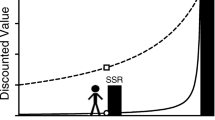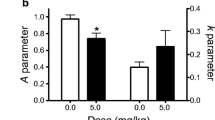Abstract
Rationale
Rate dependence refers to an orderly relationship between a baseline measure of behavior and the change in that behavior following an intervention. The most frequently observed rate-dependent effect is an inverse relationship between the baseline rate of behavior and response rates following an intervention. A previous report of rate dependence in delay discounting suggests that the discounting of delayed reinforcers, and perhaps, other impulsivity measures, may change rate dependently following acute and chronic administration of potentially therapeutic medications in both preclinical and clinical studies.
Objective
The aim of the current paper was to review the effects of stimulants on delay discounting and other impulsivity tasks.
Methods
All studies identified from the literature were required to include (1) an objective measure of impulsivity; (2) administration of amphetamine, methylphenidate, or modafinil; (3) presentation of a pre- and postdrug administration impulsivity measure; and (4) the report of individual drug effects or results in groups split by baseline or vehicle impulsivity. Twenty-five research reports were then reanalyzed for evidence consistent with rate dependence.
Results
Of the total possible instances, 67 % produced results consistent with rate dependence. Specifically, 72, 45, and 80 % of the data sets were consistent with rate dependence following amphetamine, methylphenidate, and modafinil administration, respectively.
Conclusions
These results suggest that rate dependence is a more robust phenomenon than reported in the literature. Impulsivity studies should consider this quantitative signature as a process to determine the effects of variables and as a potential prognostic tool to evaluate the effectiveness of future interventions.













Similar content being viewed by others
References
Acheson A, de Wit H (2008) Bupropion improves attention but does not affect impulsive behavior in healthy young adults. Exp Clin Psychopharmacol 16:113–23. doi:10.1037/1064-1297.16.2.113
Arnsten AFT (2009) Toward a new understanding of attention-deficit hyperactivity disorder pathophysiology: an important role for prefrontal cortex dysfunction. CNS Drugs 23(Suppl 1):33–41. doi:10.2165/00023210-200923000-00005
Barbelivien A, Billy E, Lazarus C et al (2008) Rats with different profiles of impulsive choice behavior exhibit differences in responses to caffeine and d-amphetamine and in medial prefrontal cortex 5-HT utilization. Behav Brain Res 187:273–83. doi:10.1016/j.bbr.2007.09.020
Barrett JE, Katz JL (1981) Drug effects on behaviors maintained by different events. In: Thompson T, Dews PB, McKim WA (eds) Advances in behavioral pharmacology. Academic, New York, pp 119–163
Bickel WK, Higgins ST, Kirby K, Johnson LM (1988) An inverse relationship between baseline fixed-interval response rate and the effects of a tandem response requirement. J Exp Anal Behav 50:211–218
Bickel WK, Jarmolowicz DP, Mueller ET et al (2012) Are executive function and impulsivity antipodes? A conceptual reconstruction with special reference to addiction. Psychopharmacology (Berl) 221:361–87. doi:10.1007/s00213-012-2689-x
Bickel WK, Jarmolowicz DP, Mueller ET, Gatchalian KM (2011) The behavioral economics and neuroeconomics of reinforcer pathologies: implications for etiology and treatment of addiction. Curr Psychiatry Rep 13:406–15. doi:10.1007/s11920-011-0215-1
Bickel WK, Koffarnus MN, Moody L, Wilson AG (2014a) The behavioral- and neuro-economic process of temporal discounting: a candidate behavioral marker of addiction. Neuropharmacology 76 Pt B:518–27. doi: 10.1016/j.neuropharm.2013.06.013
Bickel WK, Landes RD, Kurth-Nelson Z, Redish AD (2014b) A quantitative signature of self-control repair: rate-dependent effects of successful addiction treatment. Clin Psychol Sci. doi:10.1177/2167702614528162
Bickel WK, Miller ML, Yi R et al (2007) Behavioral and neuroeconomics of drug addiction: competing neural systems and temporal discounting processes. Drug Alcohol Depend 90(Suppl 1):S85–91. doi:10.1016/j.drugalcdep.2006.09.016
Bickel WK, Moody L, Quisenberry AJ, et al. (2014c) A competing neurobehavioral decision systems model of SES-related health and behavioral disparities. Prev Med (Baltim) 4–10. doi: 10.1016/j.ypmed.2014.06.032
Bickel WK, Moody L, Quisenberry AJ (2014d) Computerized working-memory training as a candidate adjunctive treatment for addiction. Alcohol Res Curr Rev 36:123–126
Bickel WK, Quisenberry AJ, Moody L, Wilson AG (2014e) Therapeutic opportunities for self-control repair in addiction and related disorders: change and the limits of change in trans-disease processes. Clin Psychol Sci. doi: 10.1177/2167702614541260
Blance A, Tu Y-K, Baelum V, Gilthorpe MS (2007) Statistical issues on the analysis of change in follow-up studies in dental research. Community Dent Oral Epidemiol 35:412–420. doi:10.1111/j.1600-0528.2007.00407.x
Branch MN (1984) Rate dependency, behavioral mechanisms, and behavioral pharmacology. J Exp Anal Behav 3:511–522
Browne JP, van der Meulen JH, Lewsey JD et al (2010) Mathematical coupling may account for the association between baseline severity and minimally important difference values. J Clin Epidemiol 63:865–874. doi:10.1016/j.jclinepi.2009.10.004
Cohen J (1992) A power primer. Psychol Bull 112:155–159
Cools R, D’Esposito M (2011) Inverted-U-shaped dopamine actions on human working memory and cognitive control. Biol Psychiatry 69:e113–25. doi:10.1016/j.biopsych.2011.03.028
de Wit H, Crean J, Richards JB (2000) Effects of d-amphetamine and ethanol on a measure of behavioral inhibition in humans. Behav Neurosci 114:830–837. doi:10.1037//0735-7044.114.4.830
de Wit H, Enggasser JL, Richards JB (2002) Acute administration of d-amphetamine decreases impulsivity in healthy volunteers. Neurospsychopharmacology 27:813–82
Dews P (1977) Rate-dependency hypothesis. Science (80) 198:1182–1183. doi:10.1126/science.563103
Dews PB (1958) Studies on behavior. IV. Stimulant actions of methamphetamine. J Pharmacol Exp Ther 122:137–147
Dews PB (1954) Studies on behavior. I. Differential sensitivity to pentobarbital of pecking performance in pigeons depending on the schedule of reward. J Pharmacol Exp Ther 393–401
Durana JH, Barnes PA (1993) A neurodevelopmental view of impulsivity. In: The impulsive client: theory, research, and treatment. American Psychological Association, Washington, pp 23–37
Eagle DM, Bari A, Robbins TW (2008) The neuropsychopharmacology of action inhibition: cross-species translation of the stop-signal and go/no-go tasks. Psychopharmacology (Berl) 199:439–56. doi:10.1007/s00213-008-1127-6
Eagle DM, Robbins TW (2003) Inhibitory control in rats performing a stop-signal reaction-time task: effects of lesions of the medial striatum and d-amphetamine. Behav Neurosci 117:1302–17. doi:10.1037/0735-7044.117.6.1302
Eagle DM, Tufft MRA, Goodchild HL, Robbins TW (2007) Differential effects of modafinil and methylphenidate on stop-signal reaction time task performance in the rat, and interactions with the dopamine receptor antagonist cis-flupenthixol. Psychopharmacology (Berl) 192:193–206. doi:10.1007/s00213-007-0701-7
Feola TW, De Wit H, Richards JB (2000) Effects of d-amphetamine and ethanol on a measure of behavioral inhibition in rats. Behav Neurosci 114:838–848. doi:10.1037//0735-7044.114.4.838
Fernando ABP, Economidou D, Theobald DE et al (2012) Modulation of high impulsivity and attentional performance in rats by selective direct and indirect dopaminergic and noradrenergic receptor agonists. Psychopharmacology (Berl) 219:341–52. doi:10.1007/s00213-011-2408-z
Finke K, Dodds CM, Bublak P et al (2010) Effects of modafinil and methylphenidate on visual attention capacity: a TVA-based study. Psychopharmacology (Berl) 210:317–29. doi:10.1007/s00213-010-1823-x
Fletcher PJ, Soko AD, Higgins GA (2013) Impulsive action in the 5-choice serial reaction time test in 5-HTc receptor null mutant mice. Psychopharmacology (Berl) 226:561–70. doi:10.1007/s00213-012-2929-0
Hamidovic A, Dlugos A, Palmer AA, de Wit H (2010) Catechol-O-methyltransferase val158met genotype modulates sustained attention in both the drug-free state and in response to amphetamine. Psychiatr Genet 20:85–92. doi:10.1097/YPG.0b013e32833a1f3c
Hand DJ, Fox AT, Reilly MP (2009) Differential effects of d-amphetamine on impulsive choice in spontaneously hypertensive and Wistar-Kyoto rats. Behav Pharmacol 20:549–53. doi:10.1097/FBP.0b013e3283305ee1
Harrison AA, Everitt BJ, Robbins TW (1997) Central 5-HT depletion enhances impulsive responding without affecting the accuracy of attentional performance: interactions with dopaminergic mechanisms. Psychopharmacology (Berl) 133:329–342. doi:10.1007/s002130050410
Huskinson SL, Krebs CA, Anderson KG (2012) Strain differences in delay discounting between Lewis and Fischer 344 rats at baseline and following acute and chronic administration of d-amphetamine. Pharmacol Biochem Behav 101:403–416. doi:10.1016/j.pbb.2012.02.005
Kalechstein AD, De La Garza IIR, Newton TF (2010) Theories of addiction: methamphetamine users’ explanation for continuing drug use and relapse. Am J Addict 19:340–344. doi:10.1111/j.1521-0391.2010.00052.x.Modafinil
Krebs CA, Anderson KG (2012) Preference reversals and effects of D-amphetamine on delay discounting in rats. Behav Pharmacol 23:228–40. doi:10.1097/FBP.0b013e32835342ed
Levy F (2009a) The dopamine theory of attention deficit hyperactivity disorder (ADHD)
Levy F (2009b) Dopamine vs noradrenaline: inverted-U effects and ADHD theories. Aust N Z J Psychiatry 43:101–108
Loos M, Staal J, Schoffelmeer ANM et al (2010) Inhibitory control and response latency differences between C57BL/6J and DBA/2J mice in a go/no-go and 5-choice serial reaction time task and strain-specific responsivity to amphetamine. Behav Brain Res 214:216–24. doi:10.1016/j.bbr.2010.05.027
MathWorks (2014) MATLAB_R2014a
Mazur JE (1987) An adjusting procedure for studying delayed reinforcement. In: Commons ML, Mazur J, Nevin JA, Rachlin H (eds) Quantitative analysis of behavior: the effect of delay and of intervening events on reinforcement. Psychology Press, Hillsdale, pp 55–76
Myerson J, Green L, Warusawitharana M (2001) Area under the curve as a measure of discounting. J Exp Anal Behav 76:235–243. doi:10.1901/jeab.2001.76-235
Odum AL, Lieving LM, Schaal DW (2002) Effects of D-amphetamine in a temporal discrimination procedure: selective changes in timing or rate dependency? J Exp Anal Behav 78:195–214
Oldham PD (1962) A note on the analysis of repeated measurements of the same subjects. J Chronic Dis 15:969–977. doi:10.1016/0021-9681(62)90116-9
Perkins KA (1999) Baseline-dependency of nicotine effects: a review. Behav Pharmacol 10:597–615
Perry JL, Stairs DJ, Bardo MT (2008) Impulsive choice and environmental enrichment: effects of d-amphetamine and methylphenidate. Behav Brain Res 193:48–54. doi:10.1016/j.bbr.2008.04.019
Rapport MD, DuPaul GJ, Stoner G et al (1985) Attention deficit disorder with hyperactivity: differential effects of methylphenidate on impulsivity. Pediatrics 76:938–943
Schmaal L, Goudriaan AE, Joos L (2014) Neural substrates of impulsive decision making modulated by modafinil in alcohol-dependent patients. Psychol Med 44:2787–98. doi:10.1017/S0033291714000312
Solanto MV (1998) Neuropsychopharmacological mechanisms of stimulant drug action in attention-deficit hyperactivity disorder: a review and integration. Behav Brain Res 94:127–152. doi:10.1016/s0166-4328(97)00175-7
Solanto MV (1984) Neuropharmacological basis of stimulant drug action in attention deficit disorder with hyperactivity: a review and synthesis. Psychol Bull 95:387–409
Stanis JJ, Burns RM, Sherrill LK, Gulley JM (2008) Disparate cocaine-induced locomotion as a predictor of choice behavior in rats trained in a delay-discounting task. Drug Alcohol Depend 98:54–62. doi:10.1016/j.drugalcdep.2008.04.009
Stein JS, Smits RR, Johnson PS et al (2013) Effects of reward bundling on male rats’ preference for larger-later food rewards. J Exp Anal Behav 99:150–8. doi:10.1002/jeab.11
Tomlinson A, Grayson B, Marsh S et al (2014) Pay attention to impulsivity: modelling low attentive and high impulsive subtypes of adult ADHD in the 5-choice continuous performance task (5C-CPT) in female rats. Eur Neuropsychopharmacol 24:1371–80. doi:10.1016/j.euroneuro.2014.04.008
Tu YK, Gilthorpe MS (2007) Revisiting the relation between change and initial value: a review and evaluation. Stat Med 26:443–457. doi:10.1002/sim.2538
Vaidya CJ, Austin G, Kirkorian G (1998) Selective effects of methylphenidate in attention deficit hyperactivity disorder: a functional magnetic resonance study. Proc Natl Acad Sci USA 95:14494–14499
Winstanley CA, Dalley JW, Theobald DEH, Robbins TW (2003) Global 5-HT depletion attenuates the ability of amphetamine to decrease impulsive choice on a delay-discounting task in rats. Psychopharmacology (Berl) 170:320–31. doi:10.1007/s00213-003-1546-3
Wooters TE, Bardo MT (2011) Methylphenidate and fluphenazine, but not amphetamine, differentially affect impulsive choice in spontaneously hypertensive, Wistar-Kyoto and Sprague-Dawley rats. Brain Res 1396:45–53. doi:10.1016/j.brainres.2011.04.040
Yan TC, Dudley JA, Weir RK, et al. (2011) Performance deficits of NK1 receptor knockout mice in the 5-choice serial reaction-time task: effects of d-amphetamine, stress and time of day. PLoS One 6:e17586. doi: 10.1371/journal.pone.0017586
Zack M, Poulos CX (2009) Effects of the atypical stimulant modafinil on a brief gambling episode in pathological gamblers with high vs. low impulsivity. J Psychopharmacol 23:660–71. doi:10.1177/0269881108091072
Acknowledgments
We would like to acknowledge all of the authors who provided individual data for our reanalyses.
Author information
Authors and Affiliations
Corresponding author
Ethics declarations
Conflict of interest
The authors declare that they have no competing interests.
Funding
This study received funding support (R01DA034755 and R01AA021529).
Rights and permissions
About this article
Cite this article
Bickel, W.K., Quisenberry, A.J. & Snider, S.E. Does impulsivity change rate dependently following stimulant administration? A translational selective review and re-analysis. Psychopharmacology 233, 1–18 (2016). https://doi.org/10.1007/s00213-015-4148-y
Received:
Accepted:
Published:
Issue Date:
DOI: https://doi.org/10.1007/s00213-015-4148-y




